
We are celebrating 15 years — and counting — of stories that are deeply researched and deeply felt, that build a historical record of what the city has been.
We are celebrating 15 years — and counting — of stories that are deeply researched and deeply felt, that build a historical record of what the city has been.
Last summer, Susanne Schindler and Juliette Spertus spent “A Few Days in the Bronx,” comparing the iconic and insular Co-Op City to the less well-known development of Twin Parks, a scattered-site urban renewal project in the central Bronx creating over 2,000 units of housing in mid- to high-rise buildings integrated into the existing neighborhood fabric and its varied topography. That investigation piqued a curiosity that has led them to dig deeper into the history of Twin Parks, searching for answers to elusive questions about the role of design in contributing to the “success” of low-income, subsidized housing. Together with architectural historian Mariana Mogilevich, Schindler and Spertus are compiling the “Twin Parks Archive,” an online exhibit on the history, lived-in reality, and possible futures of the development as a resource to expand this discussion.
As part of this extensive and ongoing inquiry, Schindler and Spertus convened twelve of the people closely involved in the planning, design, and implementation of Sites 5/11 and Site 4 of Twin Parks, a tower and courtyard designated during the process as Twin Parks Northwest, to revisit the buildings, forty years after their construction. In the article below, this site visit serves as a point of departure for an exploration of how, when it comes to evaluating success, design — particularly for shared, open space — is inextricable from issues of management, maintenance, and use over time. –C.S.
Defining Success
“Do you have any ideas? [I’m looking for] good examples of affordable housing/public housing from the past that have been a huge success. In part because of the architecture.“
This question, recently asked by a leading advocate for better design in affordable housing in the United States, took us by surprise. We had assumed everyone trained in architecture had internalized the textbook examples: Weissenhof, Unité, Harlem River Houses, IBA 84 Berlin. What notion of “success” were we talking about? The canonical status in architecture of these buildings clearly has not been determined by the socio-economic status of their residents or the contemporary condition of the buildings; their “success” as places to live is not why architects study them. Some are physically deteriorated and plagued by violence while others, in great shape, have been privatized and thus foregone their original purpose as social housing.
“Successful in which respect?”
“Like Via Verde,” the advocate responded.
Is Via Verde a success? we wondered. Certainly the 200-unit project by Grimshaw Dattner Phipps Rose stands out above the average contemporary affordable housing project in terms of siting, program, typology, and detailing. It has been published internationally and has received numerous awards. But Via Verde is not even two years old. We know nothing about what it will be like in 10, 20, or 40 years. Whether the single entry point across a shared courtyard will be loved, as now, or feared. Whether the roof gardens will be kept up. Whether the building will still be home to households of varying income levels. By which criteria, and in terms of which timeframe do you judge the “success” of architecture in housing? How can we advocate for better design if we can’t relate it to non-design issues such as management, maintenance, and use, in both the short and long term? How can we advocate for better housing if we don’t know our past, right there in our backyards?
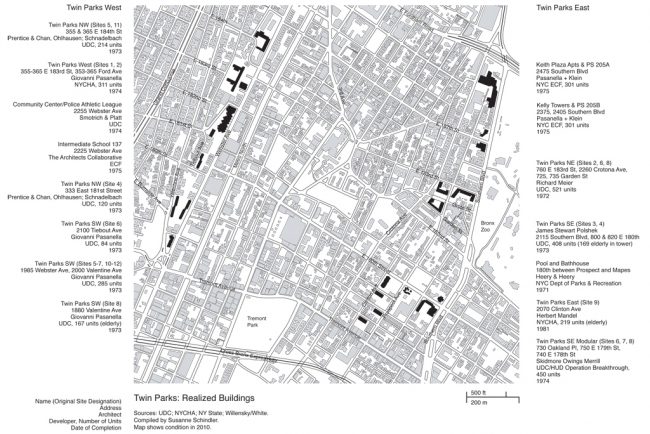
Realized Twin Parks Developments | Data compiled by Susanne Schindler. Map shows condition in 2010 | Click to enlarge
Twin Parks as Precedent
The question of how design can contribute to the success of housing led us to think again about Twin Parks.
Twin Parks was the Via Verde of its day, only ten times bigger. The scattered-site urban renewal project in the central Bronx, completed in the early 1970s, created more than 2,000 apartments and received international coverage in housing textbooks, environmental psychology studies, and architectural theory journals. Designed by six different architects on 12 distinct sites, it marked a shift away from the modern “tower-in-the-park” planning ideal to a “scattered-site” and “contextual” approach. Twin Parks is one of the seemingly few examples in late-20th century U.S. housing where architectural quality was seen as integral to the quantitative socio-political goals of housing. However, like most celebrated architecture, including Via Verde, the accolades of Twin Parks were an opening-day phenomenon.
Conversations about how architecture can contribute to the “success” of housing would be much more constructive if they considered the element of time. Oddly, this is precisely what the New York State Urban Development Corporation (UDC), responsible for the construction of Twin Parks, had set out to do. Its work was greatly informed by studies of resident preferences and patterns of life, tracked in numerous social science studies the agency had commissioned between 1968 and 1975. The UDC specifically hired architects to innovate the unit typologies and urban design of housing, and the designs were systematically evaluated for their “livability” after residents had moved in.
Yet today, Twin Parks has been largely forgotten. While it is occasionally cited as a precedent for its innovative unit typologies, Twin Parks goes unnoticed as a case study of high-rise housing for neighborhood revitalization. Why? Perhaps because, shortly after its completion, the buildings were deemed to be a failure: they had not slowed the rapid change in their neighborhoods; stories of gang violence dominated coverage from the start. Meanwhile, at precisely the moment Twin Parks welcomed its first residents, political support for large-scale housing production ended. Direct federal funding was replaced by a system of indirect tax credits or vouchers, and the state-built Twin Parks model was dismissed as passé. The buildings continue to exist, however, as income-restricted, moderate-income rental housing. With 40 years under its belt, could Twin Parks help us define a notion of success, and perhaps even provide a useful example for housing advocates?
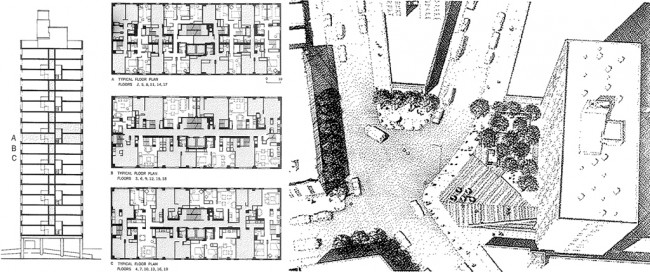
Twin Parks Northwest, the tower | Cross section and floor plans as published in Architectural Forum in 1973 (L); Aerial perspective by Terry Schnadelbach (R) | Click to enlarge
We decided to look again at the two buildings designed by Prentice & Chan, Ohlhausen in collaboration with Terry Schnadelbach for Twin Parks Northwest, located at 355-365 East 184th Street and 333 East 181st Street. Since the designers, well into their 70s now, are alive and were interested, we seized the opportunity to visit the buildings with them this past July. For most of the twelve former and current protagonists in the story of these buildings, it was the first time in 40 years that they had been back. Both sites straddle the Webster escarpment, a steep rocky slope up to 60 feet high dividing West Belmont and the Grand Concourse above from East Belmont and Webster Avenue below. In the June 1973 issue of Architectural Forum, the projects were heralded by both Suzanne Stephens and Kenneth Frampton in their reviews as the “most successful” of the Twin Parks projects, precisely because the design of their public open space was framed more sensitively than Richard Meier’s piloti-supported block fragments at Twin Parks Northeast or Giovanni Pasanella’s hovering slabs at Twin Parks Southwest. They were also more differentiated than Polshek’s tower and mid-rise building pair at Twin Parks Southeast. We agree. We suspect that this success may have to do with the early involvement of Schnadelbach, the only landscape designer ever credited in publications on Twin Parks.
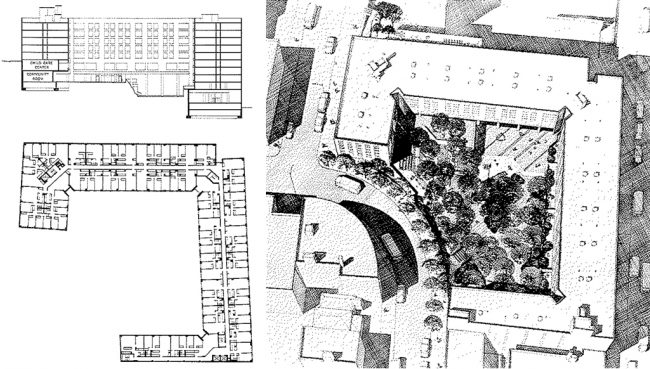
Twin Parks Northwest, the courtyard | Cross section and typical floor plan as published in Architectural Forum in 1973 (L); Aerial perspective by Terry Schnadelbach (R) | Click to enlarge
Oasis
The C-shaped courtyard building of Twin Parks Northwest with its 215 studio to five-bedroom apartments can be thought of as a double-loaded L-shaped building connected to a single-loaded I. Making use of the overall 54-foot drop in topography, the building has a single roof line, but varies from five stories at the corner of Marion Avenue, to seven stories at the courtyard, to ten stories at Webster Avenue. The two building entrances are accessed from 184th Street across open galleries looking into the courtyard below. Three levels of parking, embedded into the rock, can be reached from Webster Avenue. A nursery school has an independent access from Marion Avenue. But the key feature is the courtyard. Measuring roughly 150 by 150 feet, it was designed to work at several registers at once: as a visual anchor for the streetscape; as a series of distinct play or sitting areas for the residents; and as a public connection between 184th Street, the P.S. 085 schoolyard, and Webster Avenue.
“I love the view from here,” Schnadelbach announced as the group approached from 184th Street. “You see the tree tops. [You] get a sense that there is a park or some public space.” Schnadelbach used the topography to create what he calls an “oasis,” the only spot of green, visible from several directions against the brick building façades. Schnadelbach chose alianthus trees, considered weed trees, not for the color of the foliage or the shape of the canopy but because they are well adapted to the punishing urban environment. Schnadelbach explained that in the mid-1960s he had worked alongside Ian McHarg, author of Designing with Nature, at the University of Pennsylvania. At the time, most landscape architects were focused on suburban environments, office parks, and residential gardens. Schnadelbach became interested in applying landscape ecology ideas to cities and began an inventory of volunteer plants that grew untended in cities’ streets and parks.
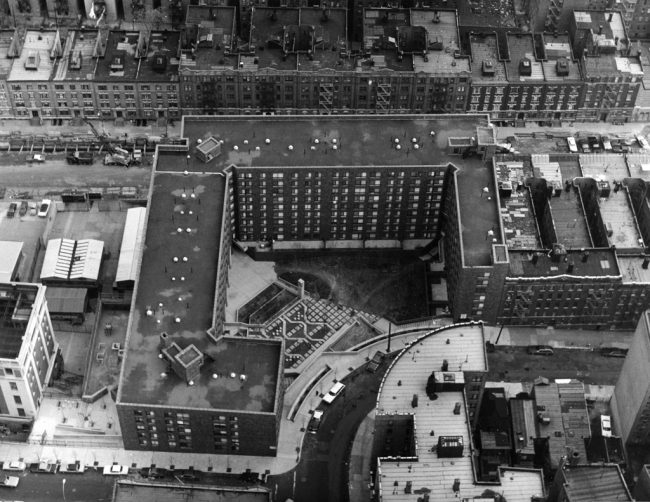
The courtyard, 1973. Aerial photograph looking east, with Webster Avenue in background | Image courtesy of Lo-Yi Chan
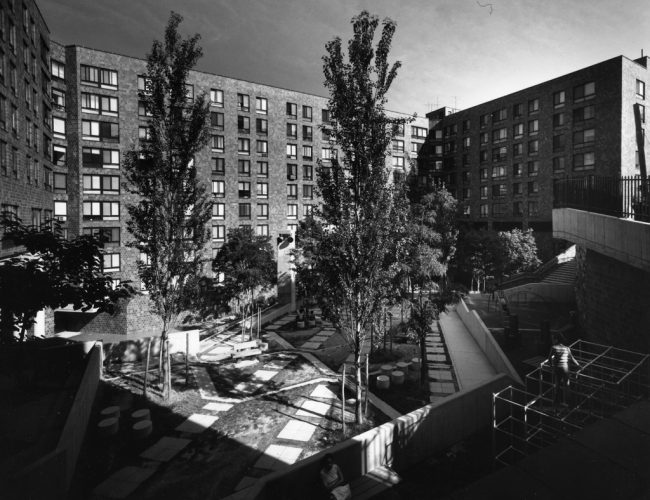
The courtyard, 1973, looking from community rooms diagonally across the “oasis” | Photo by Norman McGrath, courtesy of Lo-Yi Chan
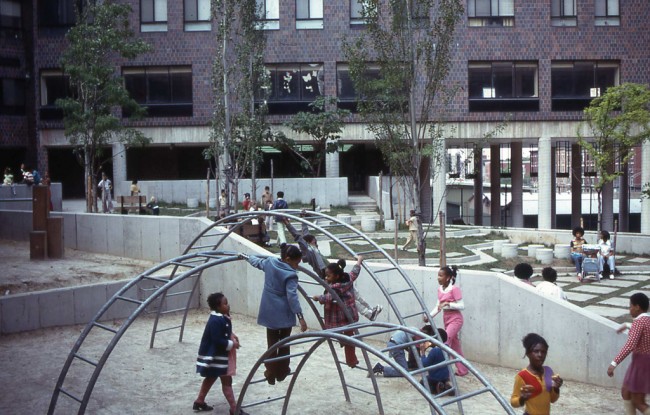
The courtyard, circa 1973, looking north from playground through portico | Image courtesy of Terry Schnadelbach
From 184th Street, a single stair leads down to the center of the courtyard. Here, play and seating areas in front of the community and laundry rooms were organized around gradual concrete steps filled with grass, negotiating the terrain. Like the rug in a living room, the intricate pattern of pavers set among green created a focal point for the space, a visual attraction for residents, childcare users, and passers-by alike. And then, at the lower courtyard level, there is the three-story-high portico, a space almost spiritual in its proportions, structured by 20 round concrete columns. This portico was intended as a gesture of opening the building, presenting itself almost as a fortress on the Webster Avenue side, while functioning as a breezeway to help cool the courtyard in summer and provide a covered play space in rain or snow. At one side, a sculptural concrete stair is splayed against an outcropping of bedrock, large enough to provide seating, and connecting the nursery school above to the courtyard below.
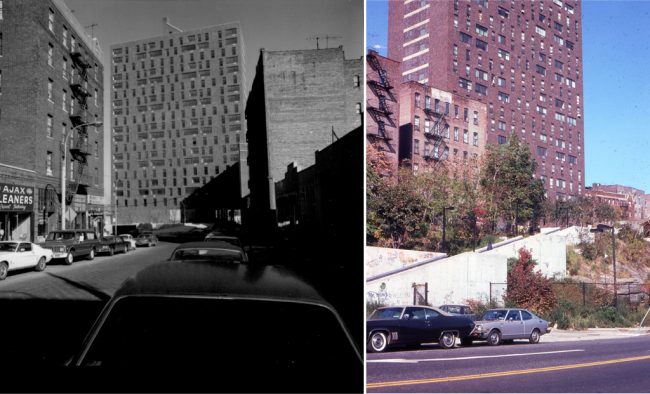
The tower seen from 181st Street in 1973, shortly before completion, photo by Norman McGrath (L) and the tower, looking up the escarpment from Webster Avenue (R) | Images courtesy of Lo-Yi Chan (L) and Terry Schnadelbach (R)
Outlook
If the courtyard at Twin Parks Northwest is introverted, hugging the slope and framing a garden, the tower is an extrovert, a beacon, visible from afar. The 19-story, 120-unit tower’s distinct and seemingly irregular window pattern hints at the mix of one-level and floor-through duplex units inside, organizing studio to five-bedroom apartments in stacks of three stories; the window proportions read like a subtle homage to the double-hungs in the neighboring six-story pre-war apartment buildings. The innovative unit layouts of the tower were and continue to be published, though their connection to the urban design considerations implicit in the building’s siting goes unmentioned. The UDC was so pleased with the result that three identical versions were built in Coney Island. But in this location, the way the tower relates to Crane Square in front and the rocky escarpment behind gives what would otherwise be an abstract slab a clearly defined front and back. Facing west, the tower is the culmination of 181st Street and the backdrop to the non-orthogonal intersection of 181st Street with Tiebout Avenue and Filon Street.
Linking front and back is a pedestrian passageway extending 181st Street through a two-story opening in the building to a set of public stairs, almost baroque in its staggered descent, halting and offsetting its course at three landings to Webster Avenue 50 feet below. The passage underneath the building is split into two levels by a low wall: residents proceed up a ramp to the building entry as passers-by continue at grade to the stair beyond. A laundry room at lobby level connects to a back patio identified on the plans as “mother’s watch” because it was originally furnished with play structures and planted with fragrant herbs.
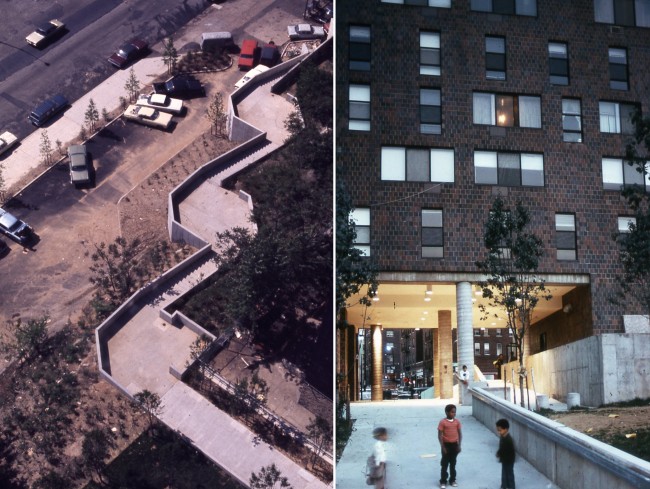
The tower, 1973. Public stair leading down to Webster Avenue and former resident parking lot (L) and public passageway connecting through a large opening to Crane Square behind (R) | Images courtesy of Terry Schnadelbach
Muscles and Bones
40 years after its completion, in the courtyard, most of the trees are still standing. However, their roots are now cracking a continuous field of concrete that has been poured over the original grid of grass and pavers. While the play equipment has been updated, the glass façade of the community room has been replaced by concrete block, preventing the visual connection between the interior and exterior. At the portico, fences cut off the connection between the courtyard from the school, and the stair has been closed off to the levels above.
At the tower, there are no fences; the original open space configuration is intact and seems to work. The plaza is well used and anyone is welcome to walk through the columns, even if the stair is unkempt and the overgrown slope it traverses is strewn with garbage. On the back patio, however, the children’s area, the sand box, and the herbs are long gone; there is no longer the intended play space adjacent to the laundry room, which UDC’s design guidelines had mandated. And the “lookout,” a tiny concrete room on the edge of the patio where children could hang out and play “cowboys and Indians,” was filled in, blocking the view it used to frame.
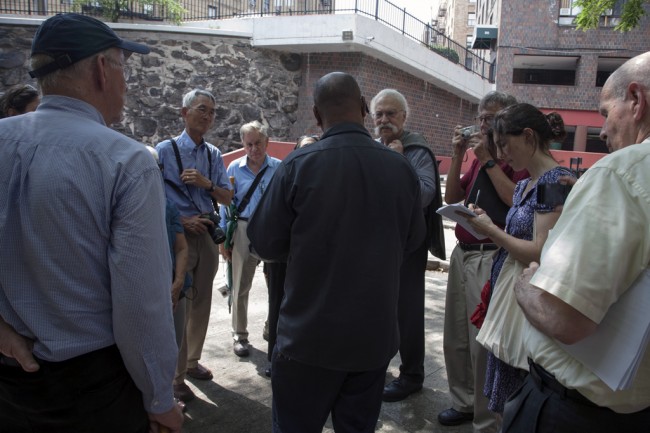
Superintendent Steven Webster, center, speaking to the group: (L to R) Francis Wickham, Lo-Yi Chan, Myles Weintraub, Ted Liebman, Terry Schnadelbach, Juliete Spertus, and Dan Donovan | Photo by Kate Milford
After discussing the various design elements at both sites, Steven Webster, the superintendent of 24 years who took us around on the tour, was incredulous, as if the building was created for someone he’d never met: “Since you built this building: who did you really think was going to live here?” Francis Wickham, project architect at the time, answered: “It was anticipated that this housing would serve people living here [in the neighborhood]. Anthropological studies were done to see how people lived [to inform our design].” Myles Weintraub, architect and planner and one of the members of the original Twin Parks study, added that not displacing residents “was one of the selling points [of Twin Parks].” Webster seemed unconvinced. Lo-Yi Chan, partner-in-charge at Prentice & Chan, Ohlhausen, turned the question around. “Who lives here now?” One word seemed to suffice as an answer: “Low-income,” Webster replied.
The conversation suggested that current management either does not consider these original amenities something residents with lower than average incomes could appreciate, or that that the upkeep of these amenities is not a cost-benefit priority. Filling in windows and covering grass, while explained as cost-saving measures or responses to security and vandalism concerns, reveal a particular attitude about exterior spaces and common rooms. They are considered residual, potential “dead zones,” as Webster referred to the portico. Rather than outdoor rooms to be appropriated — places where toddlers ride tricycles when it is raining — or extensions of the public realm of the street, these spaces are considered liabilities to be minimized and controlled.
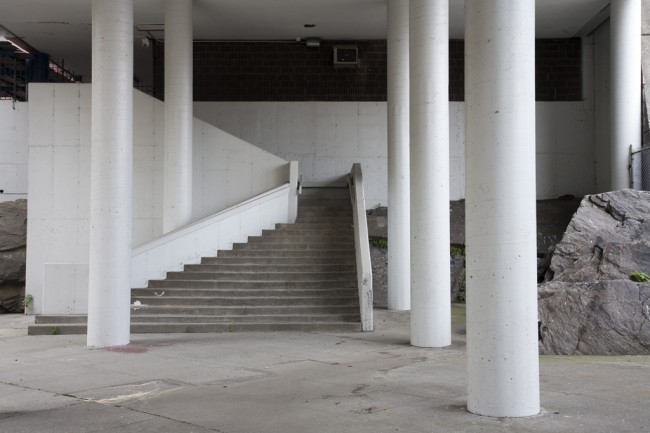
Portico and splayed stair at the courtyard today. The connection to the community spaces above and to the public school at right have been severed. | Photo by Kate Milford
The overseeing regulatory agency, the New York State Department of Homes and Community Renewal (DHCR), seems to share this attitude. A month after our visit, on August 14, New York State announced $163 million of funding to make necessary physical improvements to three Twin Parks complexes, including the courtyard and tower at Twin Parks Northwest, and preserve their affordability for another 40 years. The press release outlines the scope of work in detail, from façade, roof, and windows, to lobby upgrades and new closet doors. Any mention of open space improvements is glaringly absent. DHCR officials could not be reached for comment.
The one public office that does seem concerned about the lack of attention paid to the open space is the Bureau of Planning and Development at the Bronx Borough President’s Office. Its director, Wilhelm Ronda, has repeatedly criticized that, in the wake of recent changes in ownership and a refinancing by the State at other Mitchell Lama sites in the Bronx, new owners have focused solely on upgrading the interiors while neglecting the open space; in particular, he points to the hardscaped plazas and fenced-in arcades at Richard Meier-designed Twin Parks Northeast. A conversation with an owner indicated that pursuing alternate options for these spaces is of no interest; he jokingly pointed out that if residents saw a good idea they might demand improvements.
Superintendent Webster asked about the purpose of the small structure at the center of the courtyard of Twin Parks Northwest. Schnadelbach explained that it was originally a bell tower with integrated lighting, used to illuminate the courtyard without shining light directly into apartment windows. Because the electricians’ union charged by the number of outlets, installing all of the lighting in one place saved money. Webster liked the idea of the lights. “Maybe I’ll put them back.”
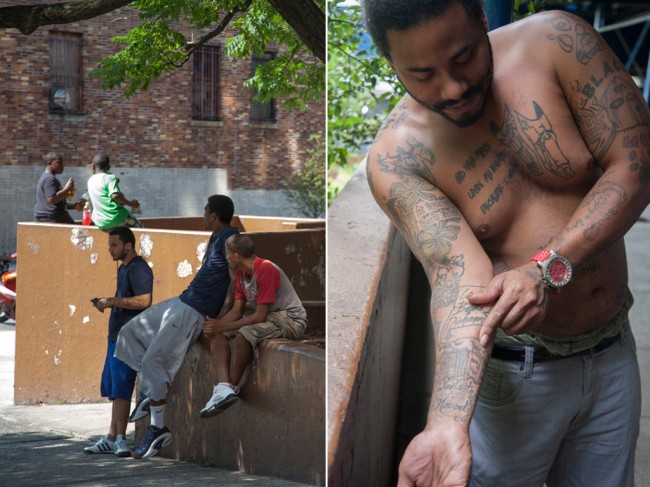
Residents of the tower lounge in Crane Square (L); Rafael displays a tattoo of his home (R). | Photos by Kate Milford
The residents’ attitudes toward the open space seem split. Lo-Yi Chan recalls that from the beginning people threw debris out of their windows, and it even had a name: “air mail.” According to Webster, this is why all but one of the private patios off of the courtyard-level apartments go unused. Falling objects are also blamed for the tower’s empty back patio. Other residents, however, seem to identify with the design intent and miss the opportunities these spaces used to provide. As our group arrived at the building after walking up the stair from Webster Avenue, several men in their 20s standing on the patio called out, “Hey, are you the architects?” They then pointed to a tattoo of building’s façade on one of the men’s forearms. Rafael, the owner of the tattoo, explained: “I’ve lived here 29 years. All my life. I love this building.” Born and raised in his grandmother’s four-bedroom duplex, he remembers playing in the concrete lookout kids called the “bat cave.” He didn’t say why they gave it that name, but it is easy to imagine it being so small that adults couldn’t fit, with a keyhole view through its tiny window high over the neighborhood, an extra-special clubhouse.
40 Years Later
So what did we learn from this joint site visit? What criteria can we develop to talk about the contribution of design to the success of housing? In an email, Weintraub summarized: “It was stimulating though disheartening in many respects. I’m thinking, of course, of the many changes for the worse in the appearance and use of the buildings and spaces. Still, the Twin Parks Northwest buildings represent a hugely positive alternative to what had been the norm in New York City.” While this assessment evaluates the buildings in their historic context, it misses the opportunity to evaluate them for today. Ted Liebman, former chief architect of the UDC, although no more optimistic about the current era, countered the reflex to dismiss Twin Parks as the product of another time: “There remain lessons to be learned from Twin Parks. Let the architects, urban planners, and environmental psychologists study this housing well, so we all can be better prepared for the next era, when housing, neighborhood, and community solutions become a priority.”
Schnadelbach, in contrast, did not qualify his statements. He was almost euphoric. He deemed the tour “a full success,” and concluded, in a series of recommendations for improvement sent to the management, “After 40 years, the overall development is as fresh as the day it opened.” Echoing this sentiment but perhaps more attuned to the realities, Lo-Yi Chan provided what to us may be the most useful way to think about how design contributes to the success of housing: “It was gratifying to see that the bones of those projects are still sound, even if the fabric is a bit frayed.” The buildings are successful because they are set up in a way that the uses they were meant to enable could easily be reactivated, or allow new uses to be introduced. If it is not practical for teachers to bring preschoolers down the stairs to the covered portico, that space could easily be used for card tables allowing seniors to take in some fresh air. If interstitial space between pilotis seems unusable, why not fill the new interior space in and have it operated by a nearby school? Finally, crime rates have dropped dramatically in recent years, and many connections once considered unmanageable might actually work today.
As to making a case for increased attention to and integration of the open space design in housing, and to explain why their firm joined forces with Schnadelbach in the first place, Wickham provided a simple quantitative argument: “You could spend a small sum to establish a quality landscape that benefited all; if the same sum were used to enhance the architecture of each unit, at best it might buy a better door knob.” On the one hand, then, the tour confirmed the central contribution landscape design can make in housing; on the other hand, it became clear how easily even well-thought-out spaces can be taken away. Schnadelbach was well aware of this during his design process. With low maintenance costs as a goal, he selected weed trees and structured the lawn with pavers so that the grass “might be taken seriously and properly maintained.” He was aware that this was “a gamble. A true role of the dice.”
Which brings us back to the request by the housing advocate. So yes, Prentice & Chan, Ohlhausen and Terry Schnadelbach’s courtyard and tower at Twin Parks Northwest are “a huge success,” in part because of the architecture and the integrated open space design. But in considering success, we need to look at not only these original “bones,” but at the string of decisions made over time by owners, residents, and regulators, each one made in response to particular circumstances, be they shifting subsidy structures, rising street crime, or a change in household composition and demographics. Buildings and their uses change over time. To ensure that the “muscle memory” of the design survives and evolves, even when money is short, we need to build ongoing relationships between designers, owners, and regulators. To avoid falling back to the lowest common denominator in housing — the “number of dwelling units” — we need to give a name and a value to the qualities that go beyond, particularly those of open space. Quantifiying those qualities is what’s so hard.
The views expressed here are those of the authors only and do not reflect the position of The Architectural League of New York.
Comments